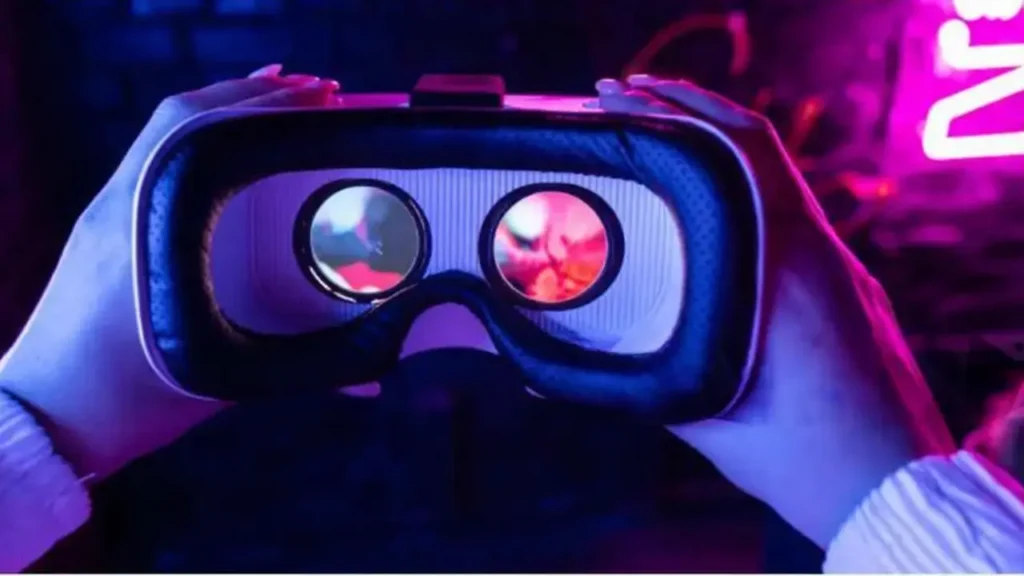
Augmented Reality has moved past the novelty phase to become a foundational technology in the era of spatial computing. Specialized augmented reality accessories and high-performance hardware are driving the next wave of innovation.
These devices act as the interface, seamlessly blending the digital and physical worlds for consumers and transforming operations for enterprises.
From lightweight AR smart glasses that offer hands-free digital overlays to sophisticated haptic feedback systems, this hardware segment is projected to dominate the overall AR market, which is on a trajectory to reach over $50 billion in revenue by 2025 and up to $599 billion by 2030.In particular, the head-mounted display market alone is projected to grow from USD 5.13 billion in 2023 to USD 44.65 billion by 2030.
In this article, we will explore the current landscape, critical device categories, and the benefits driving this exponential adoption.
Core Augmented Reality Hardware Categories
The market for immersive experiences is segmented into several key accessory types, each serving distinct use cases.
Primary Interface AR Smart Glasses and Headsets
These are the most critical spatial computing hardware devices, responsible for displaying digital content overlaid onto the real world.
| Consumer AR Glasses (e.g., XREAL Air, Google Android XR) | Lightweight, stylish, near-eye micro-displays (e.g., micro LED), often tethered to a phone for processing. Integrated AI for context-aware assistance (e.g., Gemini). | Daily media consumption, personalized information overlay, mobile gaming, social media, real-time navigation. |
| Enterprise/Mixed Reality Headsets (e.g., Microsoft HoloLens 2, Apple Vision Pro, Meta Quest Pro) | Advanced sensor fusion (LiDAR, eye-tracking), full-color pass-through for mixed reality, high-performance dedicated chipsets (e.g., Snapdragon XR series). | Remote assistance, industrial training and simulation, surgical guidance in healthcare, collaborative product design. |
Input and Interaction Accessories
For truly immersive experiences, users need more than just a display. These accessories enable precise interaction and multi-sensory feedback.
- Haptic Gloves and Suits
Devices like HaptX Gloves or Sense Glove Nova simulate the sense of touch. They use microfluidics or actuators to provide force feedback, allowing users to “feel” the texture, size, and weight of a virtual object.
Uses Advanced manufacturing training, virtual product prototyping, and AR gaming with realistic feedback.
- Degrees of Freedom Controllers
Providing spatial tracking across all axes (position and orientation), these controllers (e.g., Valve Knuckles, Meta Quest Touch Controllers) offer superior precision compared to traditional gamepads.
Uses Accurate navigation, object manipulation in enterprise AR workflows, and precision targeting in games.
- AR-Compatible Earbuds:
Accessories like Apple AirPods Pro with spatial audio support create 3D spatial audio environments, making digital sound cues and virtual assistants feel naturally anchored to the real world.

Benefits of Augmented Reality Accessories
Leveraging augmented reality accessories translates directly into measurable benefits that improve engagement and conversion.
A. For Business and Enterprise (Enterprise AR)
wide use of aR Accessories at the Industrial level is very remarkable some key points are mentioned here
| Reduced Return Rates (Retail): Customers using virtual try-on (e.g., furniture, makeup, apparel) have a better understanding of fit and scale. | High-value signal: improves product-level metrics, reduces refund-related content. Ranks for “reduce product returns with AR.” |
| Enhanced Training & Efficiency: Hands-free instructions for assembly, maintenance, or complex surgical procedures via AR glasses. | Authority content: establishes expertise in “industrial training solutions” and “remote assistance.” Targets B2B search intent. |
| Immersive Shopping: Virtual showrooms and 3D product visualization replace static 2D imagery, leading to increased session times and lower bounce rates. | Core user-experience metrics: Signals high content value to search engines. Ranks for “3D product AR” and “web AR experience.” |
B. For Consumers (Augmented Reality accessories)
| Personalized Experiences: AR-powered filters, personalized AR gaming, and custom digital content. | Social signals: Content is highly shareable, generating organic backlinks and driving viral traffic across social channels. |
| Real-Time Information: Overlays on navigation, product reviews, or historical facts based on context and location. | Local SEO: Stronger relevance for location-based search queries (“local AR,” “AR maps”). Encourages local business updates (GMB listings). |
| Everyday Utility: Lightweight and comfortable designs (e.g., XREAL Air) facilitate all-day use for tasks beyond gaming, making them a functional everyday AR device. | Long-tail content: Targets searches for “lightweight AR glasses review” or “best everyday AR headset.” |
How to Choose the Right Augmented Reality Accessories
If you are considering investing in AR accessories, here are some human-focused guidelines to help make the best choice.
Clarify Your Primary Use
Start by asking: What do I want to do with these accessories? Are you working in training, retail, gaming, education, or a mix? The right hardware depends on the goal.
For example, If you are doing industrial training, durability, field-readiness, and integration matter. If you are gaming, comfort and immersive interaction may matter more.
Check Compatibility and Ecosystem
An accessory only works if it fits your devices and the content you plan to use. Does it work with your headset, computer, or mobile device? Are there apps or software that support it? Some accessories are locked to specific platforms. Ensure your choice connects well with your existing tech or future purchases.
Evaluate Comfort, Fit, and Ergonomics
Wearables must be comfortable. If a smart glass is heavy or a glove limits your movement, you’ll use it less. Testing fit, weight, usability, and battery life matters. The more natural the accessory feels, the more value you’ll get.
Examine Tracking, Feedback, and Interaction Quality
High-quality accessories will have dependable motion tracking, low latency, and precise interaction. Does your hand controller lag? Does the audio feel disconnected? Haptic feedback should feel meaningful rather than gimmicky. These factors affect whether the accessory enhances your experience or becomes a frustration.
Look at Price Versus Return
Premium accessories might cost a lot. Consider whether your use case warrants it. A high-end enterprise glove or full-body suit may make sense in professional training, but might be overkill for casual use. Match investment to value.
Consider Upgradability and Future-Proofing
Technology moves fast. Choose accessories that allow firmware updates, have modular parts, or fit into a growing ecosystem. The more you invest in accessories, the more useful future-proofing becomes. Accessories that cannot adapt may become obsolete.
Challenges and Things to Keep in Mind

No technology is perfect. Here are some of the current hurdles for augmented reality accessories.
- Cost remains a barrier. Some accessories are still expensive and aimed at professionals rather than general consumers.
- Content and application gaps. Even the best accessory doesn’t shine if there are few compelling experiences.
- Wearability issues. Bulky headsets, heavy gloves, or uncomfortable mounts reduce adoption.
- Technical limitations. Tracking accuracy, display clarity, latency, and field of view are still improving.
- Market adoption can be slow. Despite the hype, some segments (especially consumer wearables) face slower uptake. For example, a recent report noted a decline in headset shipments in 2025, followed by an expected rebound.
- Privacy and ergonomics. Wearables that record, sense, or map environments raise questions about data, comfort, and social acceptance.
What is the future of augmented reality accessories?
The future of augmented reality accessories lies in improved wearability, comfort, and integration with spatial computing systems. Upcoming devices will feature thinner displays, longer battery life, and better connectivity with 5G networks. These innovations will make AR gear lighter, more stylish, and a natural part of daily life, just as smartphones became indispensable within a decade.
Conclusion
The maturity of Augmented Reality Accessories marks a definitive shift from mobile-based AR to dedicated, high-performance spatial computing hardware. Advancements in miniaturization, battery life, and powerful processors are making devices like AR smart glasses comfortable and functional for daily use.
For businesses, this technology provides an unparalleled competitive edge, driving efficiency in enterprise AR and revolutionizing customer experience in retail through virtual try-on and immersive experiences.
By focusing on robust hardware and optimizing as mixed reality and real-time rendering, brands can capture significant organic traffic in this rapidly expanding market, ensuring they are positioned at the forefront of the digital future. The future is not just augmented; it is integrated.
FAQs
What are augmented reality accessories?
Augmented reality accessories are physical devices that enhance or enable AR experiences by combining digital visuals and real-world elements. These include smart glasses, AR headsets, motion controllers, haptic gloves, and spatial-audio earbuds that let you see, hear, and interact with digital content around you.
How do augmented reality accessories improve the AR experience?
These accessories improve immersion by creating more natural and interactive experiences. For instance, haptic gloves let you feel virtual textures, motion sensors track your hand gestures, and AR headsets overlay digital instructions or visuals in real time. Together, they make the augmented experience more realistic, responsive, and engaging.
Which industries benefit the most from augmented reality accessories?
Augmented reality accessories are widely used in industries such as healthcare, education, manufacturing, retail, and entertainment. Surgeons use AR glasses for guided operations, teachers use AR headsets for interactive lessons, and retailers use AR tools for virtual product try-ons. These accessories make training, shopping, and learning more efficient and immersive.
Are augmented reality accessories affordable for consumers?
Prices vary depending on the device and its purpose. Consumer-level smart glasses or spatial earbuds can cost a few hundred dollars, while advanced enterprise AR headsets or haptic suits can cost several thousand dollars. As augmented reality technology matures, costs are expected to decrease, making AR accessories more accessible for everyday users.


